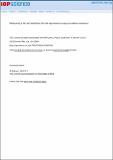| dc.contributor.author | Solomon, Susan | |
| dc.contributor.author | Friedlingstein, Pierre | |
| dc.contributor.author | Peters, Glen P. | |
| dc.contributor.author | Andrew, Robbie M. | |
| dc.date.accessioned | 2016-03-10T16:00:25Z | |
| dc.date.available | 2016-03-10T16:00:25Z | |
| dc.date.issued | 2015-10 | |
| dc.date.submitted | 2015-09 | |
| dc.identifier.issn | 1748-9326 | |
| dc.identifier.uri | http://hdl.handle.net/1721.1/101665 | |
| dc.description.abstract | Policy makers have called for a 'fair and ambitious' global climate agreement. Scientific constraints, such as the allowable carbon emissions to avoid exceeding a 2 °C global warming limit with 66% probability, can help define ambitious approaches to climate targets. However, fairly sharing the mitigation challenge to meet a global target involves human values rather than just scientific facts. We develop a framework based on cumulative emissions of carbon dioxide to compare the consistency of countries' current emission pledges to the ambition of keeping global temperatures below 2 °C, and, further, compare two alternative methods of sharing the remaining emission allowance. We focus on the recent pledges and other official statements of the EU, USA, and China. The EU and US pledges are close to a 2 °C level of ambition only if the remaining emission allowance is distributed based on current emission shares, which is unlikely to be viewed as 'fair and ambitious' by others who presently emit less. China's stated emissions target also differs from measures of global fairness, owing to emissions that continue to grow into the 2020s. We find that, combined, the EU, US, and Chinese pledges leave little room for other countries to emit CO[subscript 2] if a 2 °C limit is the objective, essentially requiring all other countries to move towards per capita emissions 7 to 14 times lower than the EU, USA, or China by 2030. We argue that a fair and ambitious agreement for a 2 °C limit that would be globally inclusive and effective in the long term will require stronger mitigation than the goals currently proposed. Given such necessary and unprecedented mitigation and the current lack of availability of some key technologies, we suggest a new diplomatic effort directed at ensuring that the necessary technologies become available in the near future. | en_US |
| dc.language.iso | en_US | |
| dc.publisher | IOP Publishing | en_US |
| dc.relation.isversionof | http://dx.doi.org/10.1088/1748-9326/10/10/105004 | en_US |
| dc.rights | Creative Commons Attribution | en_US |
| dc.rights.uri | http://creativecommons.org/licenses/by/3.0/ | en_US |
| dc.source | IOP Publishing | en_US |
| dc.title | Measuring a fair and ambitious climate agreement using cumulative emissions | en_US |
| dc.type | Article | en_US |
| dc.identifier.citation | Peters, Glen P, Robbie M Andrew, Susan Solomon, and Pierre Friedlingstein. “Measuring a Fair and Ambitious Climate Agreement Using Cumulative Emissions.” Environmental Research Letters 10, no. 10 (October 1, 2015): 105004. © 2015 IOP Publishing Ltd | en_US |
| dc.contributor.department | Massachusetts Institute of Technology. Department of Earth, Atmospheric, and Planetary Sciences | en_US |
| dc.contributor.mitauthor | Solomon, Susan | en_US |
| dc.relation.journal | Environmental Research Letters | en_US |
| dc.eprint.version | Final published version | en_US |
| dc.type.uri | http://purl.org/eprint/type/JournalArticle | en_US |
| eprint.status | http://purl.org/eprint/status/PeerReviewed | en_US |
| dspace.orderedauthors | Peters, Glen P; Andrew, Robbie M; Solomon, Susan; Friedlingstein, Pierre | en_US |
| dc.identifier.orcid | https://orcid.org/0000-0002-2020-7581 | |
| mit.license | PUBLISHER_CC | en_US |
